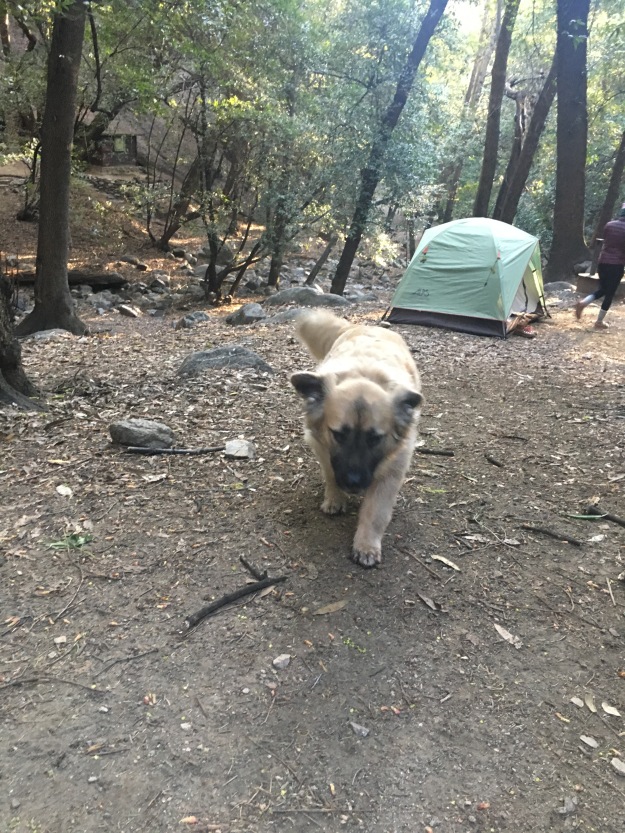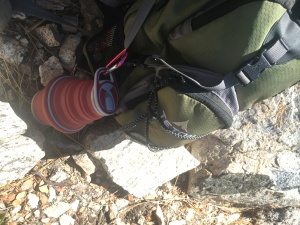
From way back when I first started hiking!
By Heather
We all start somewhere.
I look back at some of my early mistakes and cringe. My first hiking shoes were my gym shoes! Once, I didn’t know my exact route. I just showed up and did it. Not smart. I’ve also hiked with earbuds in. It’s only pure luck that got me off the trail uninjured and alive.
Today, I see others making the same mistakes. Wearing jeans and a T-shirt, carrying no food and only a single 32 oz. bottle on peaks like Mt. Baldy and Cucamonga.
If you’re new to hiking, here are a few of my tips for hiking safely and living to tell the tale:
Remember that you can die
Anyone can die when they’re hiking. Newbies, experienced people, people hiking alone, people hiking in groups. They die from small mistakes and big ones. They’re old and they’re young.
Have respect for nature and the mountain you’re on. Always, no matter how well you know it.
Sam Kim hiked Mt. Baldy almost 1,000 times before it took him this winter. He knew that mountain better than anyone. If that isn’t sobering, I don’t know what is.
Start small and work up
In Los Angeles, there’s no shortage of places to get started with hiking. Griffith Park has tons of trails of varying toughness. Santa Monica National Recreation Area has even more, from short loop trails all the way up to the Backbone Trail.
Before heading to the mountains, I spent a lot of time hiking Los Liones. It’s a great hike for those who are just starting out – gorgeous ocean views, it’s challenging but not impossible and the crowds aren’t terrible in the early morning.

Carry the 10 essentials
Have these 10 essentials, and you have the basics of what you need to stay safe:
- Map and compass
- Sunglasses/sunscreen
- Extra clothing (including extra socks!)
- Headlamp
- First-aid supplies (including moleskin and duct tape to cover blisters because bandages won’t always cut it)
- Lighter/matches
- Repair kit and tools, plus a knife
- Food
- Water
- Emergency shelter
Wear the right shoes and break them in
Wear hiking shoes or boots. Go to REI, try some on and see what feels good to you because everyone is different.
Some people like waterproof boots (me), others want trail runners, others want non-waterproof boots. Your shoes are a personal choice, so try a lot on, ask questions and weigh the pros and cons of each style.
Be sure to break them in, too. Don’t go on a 15-mile hike in brand-new boots.

Wear the right socks
You really want sock liners, which are a thin layer sock that helps wick moisture and prevent blisters.
You then want some nice, thick hiking socks. I’m very partial to my Therlos, and have turned many others onto them! Pack an extra pair in your pack, too.
Read up on how to prevent blisters.
Wear the right clothes
Cotton is the worst thing you can wear, especially on your torso. Once it’s wet, it stays wet, which will feel really unpleasant on a windy peak.
Look for moisture-wicking clothes to stay both dry and warm. On every hike, I wear a tank as the first layer, a long-sleeve moisture-wicking top and a down jacket. Sometimes I’ll add a down vest if the start temperature is really cold. Strip down and add on as needed from there!

Pack the right amount of food and drink
What’s the right amount? It varies from person to person and hike to hike.
Hiking affects my appetite in really unpredictable ways – sometimes after a relatively short hike, I’m ravenous; occasionally, I won’t be very hungry at all on a longer hike, or even afterward; other times, I could eat a horse and feel that way through several meals.
All that to say, bring enough food. More than you think you’ll need. I try to bring something to eat about once an hour, even if I don’t actually eat once an hour. Working at altitude consumes a lot of energy, so you need to stay strong.
Hiking is not diet time. This is the time where you want sugar for bursts of energy. You want salty snacks to replenish what you’ve lost in sweat.
My food and fluids usually look like this:
- 2-3 energy bars
- 2-3 energy chews
- A baggie of candies (Werther’s, Jolly Ranchers)
- 2-3 bags of other food (candy or sweet things, usually)
- Bag of pretzels or chips
- 2 32 oz. bottles of PowerAde Zero
- 2.5-L bladder
That’s generally what I bring for a five to seven hour hike on a moderately warm day, adjusting up or down for longer or shorter hikes and weather.

Half Dome all covered in clouds.
Check the weather forecast
When I first did Mt. Baldy, I didn’t check the weather. I just heard about this cool hike and went and did it. Cringe, again. Fortunately, it was a perfectly beautiful day.
Always check the weather! Especially if you’re going to a high elevation. It may be 90 down at the beach, but it may be a totally different day on top of a mountain. Generally, the temperature goes down 5 degrees for every 1,000 feet of elevation gained.
Visit Mountain Forecast to see the weather at various elevations – it goes to places weather.com doesn’t.
While you should be prepared for any situation, you’ll especially want to know if any rain, high wind or snow is expected. Rain can mean flash floods or landslides. High wind can knock you off a ridge. Hiking in snow requires experience, the right tools and training.
Be prepared to spend the night
That’s the advice Ranger Dave gave me when we met on Mt. San Gorgonio. I was indeed not totally prepared to spend the night.
I would have done fine – I always bring more food and fluid than necessary, and I layer up, so I could have stayed warm.
But I did not have an emergency bivvy on me, which would keep me warm no matter how low the temperatures dropped. Things happen, even on nice days. Storms move in, people get injured and can’t get off the mountain. Prepare for anything.
on me, which would keep me warm no matter how low the temperatures dropped. Things happen, even on nice days. Storms move in, people get injured and can’t get off the mountain. Prepare for anything.
Know the etiquette
Aside from the obvious (don’t litter), there are some other rules of etiquette to mind:
- Yield to hikers going uphill, although a lot of them will stand and let you pass because they want a break. If they do, say thank you and continue. If they don’t, wait for them. Even when it’s a big group, which frankly, I hate. You can pass them a lot more quickly than they can pass you. Grr.
- Greet passing hikers. This also changes depending on where you are. In the wilderness, especially in the early hours, it’s hellos and how are yous all around. Say hello to everyone! When you get closer to civilization, people are much less chummy and sometimes even rude.
- If you want to pass someone going slower, say “on your left” or ask to pass. Some people may not hear you hiking behind them, so say something and don’t be creepy.

Don’t be a jerk
If you want to be a certified hiking a-hole, follow these easy tips and you’ll have your badge in no time:
- Pack it in, then drop it on the ground and leave it there.
- Bag up your dog’s poop, then leave the poop by the side of the trail.
- Bring your dog on a trail where dogs aren’t allowed.
- Drop your toilet paper after you use it and let a ranger find it.
- Get out your portable speakers and share your your sweet jams with everyone else on trail.
- Smoke, then drop the butt on some dry pine needles and watch the world burn.
- Immortalize yourself by carving your initials onto a tree.
- Further immortalize yourself by spray painting any man-made structures with your name.
- Create cairns with no purpose or meaning.
- Say “You’re almost there!” to passing hikers when they’re still two miles from the summit.
- Don’t bother to learn hiking etiquette, that’s old people stuff.
- If you’re stopped for a break and you see some hikers coming up behind you, rather than waiting for them to pass before you begin the trail again, jump and cut them off. They’ll quickly overtake you, but, hey, for two and a half beautiful minutes, you were in the lead!
- Bike the trail.

Look how cool we are.
Do be cool, like Fonzie
If you want to be a hiker other hikers are happy to see, it’s easy:
- Respect solitude. Be quiet and don’t accost people who clearly want to be alone.
- Help others. If you see someone who looks like they might be struggling or injured, stop and check on them. Offer food, water or supplies if you have any to spare. Hikers take care of each other.
- Pack it in, pack it out. That includes your toilet paper and your dog’s poop.
- Greet others. Say good morning as you pass people on the trail, and stop and chat for a moment if you can. Most people on trails are so nice, and they’re also happy to dispense wisdom and help you out. Learn from your fellow hikers and get better!
- Encourage your fellow hikers! When you’re coming down from the summit and you encounter someone on their way up who is clearly struggling, let them know how great he/she is doing and how close he/she is to the top. Maybe it sounds a tad condescending, but I have always appreciated it whenever I’ve been on the receiving end.
- If you do see someone vandalizing something, don’t confront them, as much as you might want to. Do try to snap a photo or video, then report them to a ranger. Also, shame-post the photo or video to social media.




 By Heather
By Heather





















 By Heather
By Heather






 By Heather
By Heather


 By Heather
By Heather For my birthday last year, my very thoughtful mom hooked me up with four months of
For my birthday last year, my very thoughtful mom hooked me up with four months of  If you wan to hook it to your pack, it has a handle on the lid. If you have any water left when you’re done, the 21 oz. size (the largest one, which is what Cairn sent) will fit neatly into your cup holder.
If you wan to hook it to your pack, it has a handle on the lid. If you have any water left when you’re done, the 21 oz. size (the largest one, which is what Cairn sent) will fit neatly into your cup holder.


You must be logged in to post a comment.